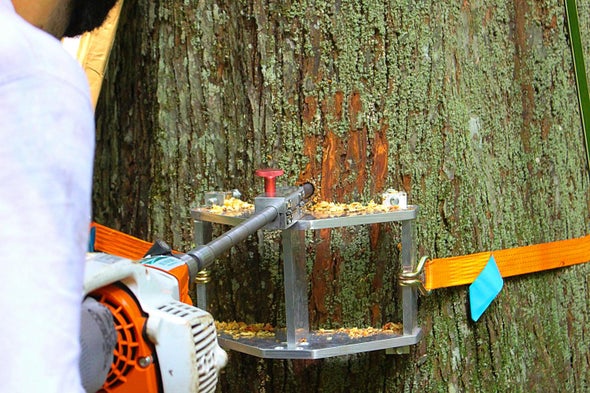(单词翻译:单击)
听力文本
This is Scientific American's 60-second Science, I'm Susanne Bard.
If you watch nature documentaries, it's easy to come away with the impression that lush tropical forests have been largely undisturbed until modern times.
"Tropical forests have sort of long been considered to be these pristine wildernesses that humans haven't really touched until recent industrial forces have started to invade them and challenge them with 21st-century capitalism."
Archaeological scientist Patrick Roberts of the Max Planck Institute for the Science of Human History.
"However, in the last two decades, archaeological data have shown that, actually, human societies have occupied and modified these environments over many millennia."
Roberts says some of the trees alive in tropical forests are up to a thousand years old. And they're sort of like time capsules, storing a record of past human activity in their tree rings, chemistry and DNA.
"So we wanted to see how different existing methods might come together to explore past tree populations, tree growth, tree ages by looking at the largest witnesses of the changes in human activity in the tropics—the trees themselves."
For example, indigenous peoples of the Amazon basin cultivated Brazil nuts for thousands of years. Roberts's colleague Victor Caetano-Andrade analyzed tree rings to determine the age and growth rates of Brazil nut trees near the city of Manaus. He found that many trees were established in the late 1600s, but there was a steep drop-off in new trees around the middle of the 18th century.

"As colonial communities came into Manaus and developed the city, they drove indigenous people out, often killing them. And what Victor found is that, actually, their growth slowed after this period without these traditional management strategies. So these Brazil nut trees that were still standing near Manaus today are actually affected by these pre- and postcolonial changes in human settlement and activity."
Another example is how communities selected for genetic traits in a variety of tropical trees, such as the cocoa tree—used, of course, to make chocolate.
"A more detailed full genome analysis of this plant has shown that humans may have even selected genes that reduced bitterness and improved its resistance to disease for their own economic benefit."
The study is in the journal Trends in Plant Science.
Roberts says recognizing tropical trees as time capsules of cultural heritage gives us yet another reason to protect them.
"Not just because of their ecological benefits, which are hugely significant, but also the information that they store about human history, about our past."
Thanks for listening for Scientific American's 60-second Science. I'm Susanne Bard.
参考译文
这里是科学美国人——60秒科学系列,我是苏珊娜·巴德。
如果你观看自然纪录片,很容易就会产生这样一种印象:茂盛的热带森林直到现代才遭到大范围破坏。
“长期以来,人们一直认为热带森林是人类未曾触碰的原始大地,直到最近,工业力量才开始入侵这里,并利用21世纪的资本主义发起挑战。”
马克斯·普朗克人类历史科学研究所的考古学家帕特里克·罗伯茨说到。
“然而,在过去二十年,考古数据表明人类社会占领并改变这些环境的历史已有数千年。”
罗伯茨说,热带森林中现存的一些树,树龄可达上千年。它们有点像时间胶囊,将远古人类活动记录在年轮、化学物质和DNA中。
“因此,我们想了解现在的不同方法如何共同探索古树的数量、生长和年龄,方法是通过观察热带地区人类活动变化的最大见证者——树木本身。”
例如,亚马逊盆地的土著人种植巴西坚果已有数千年的历史。罗伯茨的同事维克托·卡埃塔诺·安德拉德分析了年轮,以确定马瑙斯附近巴西坚果树的年龄和生长速度。他发现许多树木种植于在17世纪末,但在18世纪中叶左右,新树的种植量急剧下降。
“随着殖民者进入马瑙斯并开发城市,他们驱逐并时常杀害土著人。维克托发现,这段时期后,传统管理策略失效,树木生长速度下降。因此,这些仍然矗立在马瑙斯附近的巴西坚果树,实际上受到了人类寄居和活动在殖民前后变化的影响。”
另一个例子是,人类如何为可可树等各种热带树木选择遗传特性,当然,这是用来制作巧克力。
“对可可树更详细的完整基因组分析表明,人类甚至可能为了自身的经济利益而选择减少苦味和提高抗病性的基因。”
这项研究发表在《植物科学趋势》期刊上。
罗伯茨表示,将热带树木视为文化遗产的时间胶囊,给予我们另一个保护它们的理由。
“不仅因为它们具有非常重要的生态效益,还因为它们储存了有关人类历史和我们过去的信息。”
谢谢大家收听科学美国人——60秒科学。我是苏珊娜·巴德。
译文为可可英语翻译,未经授权请勿转载!
重点讲解
重点讲解:
1. come away with (带着某种感觉或印象)离开;
We came away with the impression that all was not well with their marriage.
我们离开时有一种印象:他们的婚姻并不十分美满。
2. look at 考虑;研究;
The examples we will look at have quite different emphases.
我们将要观察的例子所强调的重点很不相同。
3. a variety of 各式各样;多种多样;
The test is used to diagnose a variety of diseases.
此项化验可用于诊断多种疾病。
4. because of 因为;由于;
We have had to raise our prices because of rising costs.
因为成本日益上涨,我们不得不提高价格。


